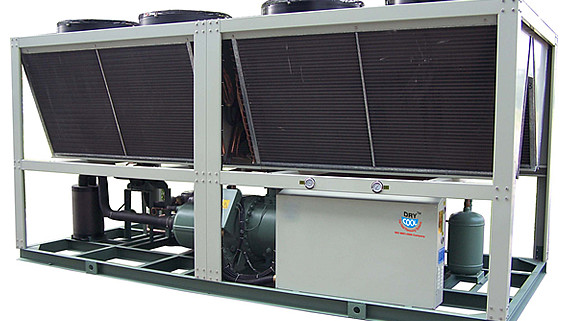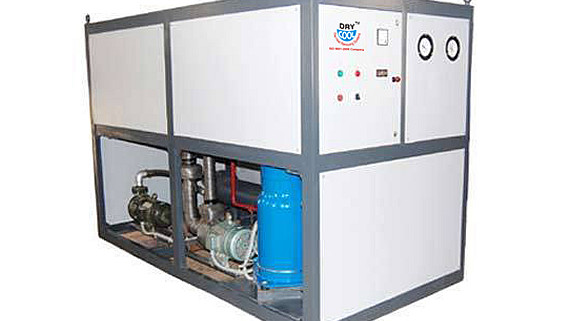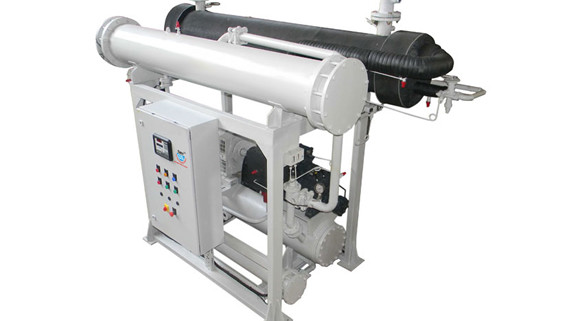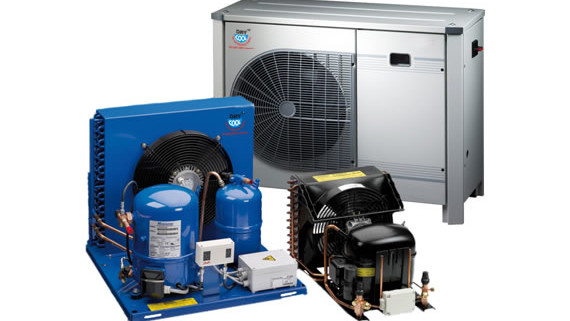CALL: +91-9811134394
Aftercoolers
The compressed air discharged from an air compressor is hot (fig. AC1-1). Compressed air at these temperatures contains large quantities of water in vapor form. As the compressed air cools this water vapor condenses into a liquid form. As an example if an aftercooler is not used, a 200 scfm compressor operating at 100 psig introduces 45 gallons of water into the compressed air system each day.
Learn more about the aftercoolers eCompressedair.com offers by viewing our product selection of aftercoolers. Compressor Outlet TemperaturesCompressor Outlet Temperatures.
| Compressor Outlet Temperatures | ||
| Type of Compressor | Average Outlet Air Temperature (°F) | Average Outlet Air Temperature (°C) |
|---|---|---|
| Oil Flooded Rotary | 200 | 93.3 |
| Oil Free Rotary | 350 | 176.6 |
| 2-Stage Reciprocating | 300 | 148.8 |
| Centrifugal | 225 | 107.2 |
| Figure AC1-1 | ||
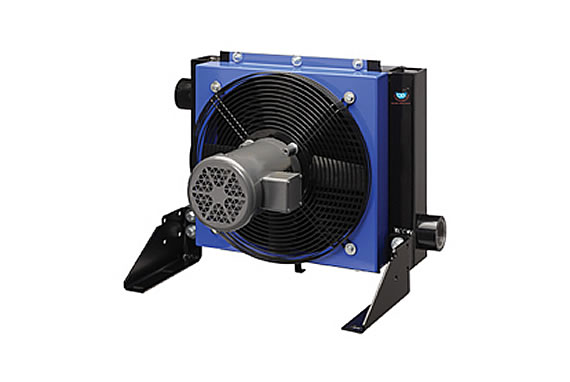
Additionally by reducing the air temperature condensate forms. Most air aftercoolers are sized to cool the air to within 5°F to 20°F (2.7°C to 11°C) of ambient air temperature. As the compressed air cools up to 75% of the water vapor present condenses to a liquid and can be removed from the system.
A moisture separator installed at the discharge of the aftercooler removes most of the liquid moisture and solids from the compressed air. Utilizing centrifugal force, moisture and solids collect at the bottom of the moisture separator. An automatic drain should be used to remove the moisture and solids.
-
Functions of compressed air aftercoolers
- Cool air discharged from air compressors via the heat exchanger
- Reduce risk of fire (Hot compressed air pipes can be a source of ignition)
- Reduce compressed air moisture level
- Increase system capacity
- Protect downstream equipment from excessive heat
Coolers are usually sized with a CTD (Cold Temperature Difference) of 5°F, 10°F, 15°F or 20°F (2.7°C, 5.5°C, 8.3°C, or 11°C). This means that the compressed air temperature at the outlet of the aftercooler will be equal to the cooling medium temperature plus the CTD when sized at the specified inlet air temperature and flow.
-
Recommended location of aftercoolers
The aftercooler should be located as close as possible to the discharge of the compressor.
-
There are two basic types of air aftercoolers:
- air-cooled
- water-cooled.
The type of aftercooler you choose depends on your preference and requirements. Compressor manufacturers may include aftercoolers within the compressor package. In general these compressors are referred to as integral aftercoolers. A stand-alone or freestanding aftercooler is a separate unit installed downstream of the compressor.
Air-Cooled Aftercooler
Air cooled aftercoolers (fig. AC1-2) use ambient air to cool the hot compressed air. The compressed air enters the air cooled aftercooler. The compressed air travels through either finned tubes or corrugated aluminum sheets of the aftercooler while ambient air is forced over the cooler by a motor-driven fan. The cooler, ambient air removes heat from the compressed air.
Belt Guard Air Cooled Aftercooler
A belt guard air-cooled aftercooler mounts to the compressor’s v-belt guard. The compressor’s belt pulley has fins designed to force ambient air over the compressor and air cooled aftercooler. The air passing over the aftercooler facilitates the heat transfer. The pulley also sends air over the compressor helping maintain proper operating temperature.
Water-Cooled Pipe Line Aftercooler
A water-cooled pipe line aftercooler comes in different styles. The most common style for compressed air service is a Shell and Tube Heat Exchanger/Aftercooler (fig. AC1-3). The pipe line aftercooler consists of a shell with a bundle of tubes fitted inside. Typically the compressed air flows through the tubes in one direction as water flows on the shell side in the opposite direction. Heat from the compressed air is transferred to the water. Water vapor forms as the compressed air cools. The moisture is removed by the moisture separator and drain valve. A modulating valve is recommended to maintain a consistent temperature and reduce water consumption. The tube bundles can be fixed or removable. Fixed tube bundles cost less but are more difficult to maintain than bundles that can be removed for cleaning or service.
Disadvantages of a water-cooled aftercooler include high water usage and difficult heat recovery.
Advantages to using a water-cooled aftercooler include better heat transfer and no required electricity.

-
Aftercooling sizing considerations
Most air aftercoolers are sized to cool the air to within 5 to 20°F (2.7°C to 11°C) of ambient air or cooling water temperature. This is called the approach temperature. Always size for the hottest day with 100% relative humidity. Sizing is dependent on the temperature of the air coming from the compressor. Typically air exiting a compressor is between 180°F (82.2°C) to 350°F (176.6°C).
To select an aftercooler, determine the approach temperature requirement (temperature above the cooling medium used) for your compressed air.
Specify 5, 10, 15, or 20°F (2.7°C, 5.5°C, 8.3°C, or 11°C) over the cooling medium temperature. Consider the temperature requirements of downstream equipment like dryers and your location’s climate.Then, based on your compressor’s CFM (cubic feet per minute) and compressed air temperature, choose an aftercooler.
-
Compressed Air System Components Temperature Requirements.
Component Normal Operating Temperature (°F) Normal Operating Temperature (°C) Average Maximum Operating Temperature* (°F) Average Maximum Operating Temperature* (°C) Standard Refrigerated Air Dryer 100 37.7 130 54.4 High Temperature Refrigerated Air Dryer 180 82.2 190 87.7 Heated Desiccant Dryer 100 37.7 120 48.8 Heated Compression Desiccant Dryer 350 176.6 375 190.5 Pressure Swing Desiccant Dryer 100 37.7 120 48.8 Standard Particulate Filter 100 37.7 150 65.5 High Temperature Particulate Filter 350 176.6 450 232.2 Coalescer Filter 100 37.7 150 65.5 Vapor Filter (Activated Charcoal) 100 37.7 150 65.5 Oil / Water Separators 100 (condensate) 37.7 (condensate) 180 (condensate) 82.2 (condensate) Drain Valves 100 37.7 180 82.2 FRL’s (polycarbonate bowl) 100 37.7 125 51.6 FRL’s (metal bowl) 100 37.7 175 79.4 These are industry average maximum operating temperatures provided for reference. Before buying or installing any compressed air component, check the actual maximum operating temperature for that particular product.
Figure AC1-4.An oversized aftercooler is usually cost-effective; it will produce cooler air with less moisture, reducing the requirements for the air dryer. Additionally, a larger aftercooler will have a lower pressure drop, lowering the necessary discharge pressure from the compressor. For the best results, size the aftercooler for a 1 to 2 psi pressure drop.
-
- Aftercooler (water-cooled): Routinely inspect, clean, check approach temperature, pressure drop and monitor water quality.
- Aftercooler (air-cooled): Inspect and clean on a regular basis. Check drain valves daily.
-
Proper maintenance will keep the aftercooler efficient. A dirty aftercooler results in both warmer air temperatures and increased pressure drop.
Rules of Thumb
- Most aftercoolers are sized to cool the air to an approach temperature of 5 to 20°F (2.7°C to 11°C) of ambient air temperature.
- Size for the hottest day with 100% relative humidity.
- Compressed air aftercoolers are located directly downstream of the compressor.
- Proper maintenance will keep the aftercooler efficient. A dirty aftercooler results in both warmer air temperatures and increased pressure drop.
-
For every 20°F (11.1°C) rise in compressed air temperature, the moisture content of the air doubles.
Learn more about the aftercoolers eCompressedair.com offers by viewing our product selection of aftercoolers.








